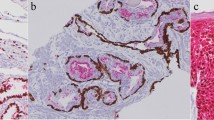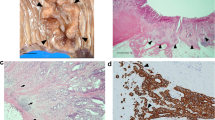Abstract
Epithelial to mesenchymal transition (EMT) is an oft-studied mechanism for the initiation of metastasis. We have recently shown that once cancer cells disseminate to a secondary organ, a mesenchymal to epithelial reverting transition (MErT) may occur, which we postulate is to enable metastatic colonization. Despite a wealth of in vitro and in vivo studies, evidence supportive of MErT in human specimens is rare and difficult to document because clinically detectable metastases are typically past the micrometastatic stage at which this transition is most likely evident. We obtained paired primary and metastatic tumors from breast and prostate cancer patients and evaluated expression of various epithelial and mesenchymal markers by immunohistochemistry. The metastases exhibited increased expression of membranous E-cadherin compared to primary tumors, consistent with EMT at the primary site and MErT at the metastatic site. However, the re-emergence of the epithelial phenotype was only partial or incomplete. Expression of epithelial markers connexins 26 and/or 43 was also increased on the majority of metastases, particularly those to the brain. Despite the upregulation of epithelial markers in metastases, expression of mesenchymal markers vimentin and FSP1 was mostly unchanged. We also examined prostate carcinoma metastases of varied sizes and found that while E-cadherin expression was increased compared to the primary lesion, the expression inversely correlated with size of the metastasis. This not only suggests that a second EMT may occur in the ectopic site for tumor growth or to seed further metastases, but also provides a basis for the failure to discern epithelial phenotypes in clinically examined macrometastases. In summary, we report increased expression of epithelial markers and persistence of mesenchymal markers consistent with a partial MErT that readily allows for a second EMT at the metastatic site. Our results suggest that cancer cells continue to display phenotypic plasticity beyond the EMT that initiates metastasis.





Similar content being viewed by others
References
Wells A, Chao YL, Grahovac J, Wu Q, Lauffenburger DA (2011) Epithelial and mesenchymal phenotypic switchings modulate cell motility in metastasis. Front Biosci 16:815–837
Condeelis JS, Wyckoff J, Segall JE (2000) Imaging of cancer invasion and metastasis using green fluorescent protein. Eur J Cancer 36:1671–1680
Tarin D, Thompson EW, Newgreen DF (2005) The fallacy of epithelial mesenchymal transition in neoplasia. Cancer Res 65:5996–6000, discussion −1
Wells A, Yates C, Shepard CR (2008) E-cadherin as an indicator of mesenchymal to epithelial reverting transitions during the metastatic seeding of disseminated carcinomas. Clin Exp Metastasis 25:621–628
Thiery JP (2002) Epithelial-mesenchymal transitions in tumour progression. Nat Rev Cancer 2:442–454
Hugo H, Ackland ML, Blick T, Lawrence MG, Clements JA, Williams ED, Thompson EW (2007) Epithelial–mesenchymal and mesenchymal–epithelial transitions in carcinoma progression. J Cell Physiol 213:374–383
Chaffer CL, Brennan JP, Slavin JL, Blick T, Thompson EW, Williams ED (2006) Mesenchymal-to-epithelial transition facilitates bladder cancer metastasis: role of fibroblast growth factor receptor-2. Cancer Res 66:11271–11278
Chao YL, Shepard CR, Wells A (2010) Breast carcinoma cells re-express E-cadherin during mesenchymal to epithelial reverting transition. Mol Cancer 9:179
Yates CC, Shepard CR, Stolz DB, Wells A (2007) Co-culturing human prostate carcinoma cells with hepatocytes leads to increased expression of E-cadherin. Br J Cancer 96:1246–1252
Kowalski PJ, Rubin MA, Kleer CG (2003) E-cadherin expression in primary carcinomas of the breast and its distant metastases. Breast Cancer Res 5:R217–R222
Bukholm IK, Nesland JM, Borresen-Dale AL (2000) Re-expression of E-cadherin, alpha-catenin and beta-catenin, but not of gamma-catenin, in metastatic tissue from breast cancer patients [seecomments]. J Pathol 190:15–19
Wong AS, Gumbiner BM (2003) Adhesion-independent mechanism for suppression of tumor cell invasion by E-cadherin. J Cell Biol 161:1191–1203
Brabletz T, Jung A, Reu S, Porzner M, Hlubek F, Kunz-Schughart LA, Knuechel R, Kirchner T (2001) Variable beta-catenin expression in colorectal cancers indicates tumor progression driven by the tumor environment. Proc Natl Acad Sci USA 98:10356–10361
Monaghan P, Clarke C, Perusinghe NP, Moss DW, Chen XY, Evans WH (1996) Gap junction distribution and connexin expression in human breast. Exp Cell Res 223:29–38
Li Z, Zhou Z, Welch DR, Donahue HJ (2008) Expressing connexin 43 in breast cancer cells reduces their metastasis to lungs. Clin Exp Metastasis 25:893–901
McLachlan E, Shao Q, Wang HL, Langlois S, Laird DW (2006) Connexins act as tumor suppressors in three-dimensional mammary cell organoids by regulating differentiation and angiogenesis. Cancer Res 66:9886–9894
Kanczuga-Koda L, Sulkowski S, Koda M, Sulkowska M (2005) Alterations in connexin26 expression during colorectal carcinogenesis. Oncology 68:217–222
Kanczuga-Koda L, Sulkowski S, Lenczewski A, Koda M, Wincewicz A, Baltaziak M, Sulkowska M (2006) Increased expression of connexins 26 and 43 in lymph node metastases of breast cancer. J Clin Pathol 59:429–433
Kanczuga-Koda L, Sulkowska M, Koda M, Rutkowski R, Sulkowski S (2007) Increased expression of gap junction protein–connexin 32 in lymph node metastases of human ductal breast cancer. Folia Histochem Cytobiol 45(Suppl 1):S175–S180
Trimboli AJ, Fukino K, de Bruin A, Wei G, Shen L, Tanner SM, Creasap N, Rosol TJ, Robinson ML, Eng C, Ostrowski MC, Leone G (2008) Direct evidence for epithelial-mesenchymal transitions in breast cancer. Cancer Res 68:937–945
Okada H, Danoff TM, Kalluri R, Neilson EG (1997) Early role of Fsp1 in epithelial-mesenchymal transformation. Am J Physiol 273:F563–F574
Mendez MG, Kojima SI, Goldman RD (2010) Vimentin induces changes in cell shape, motility, and adhesion during the epithelial to mesenchymal transition. Faseb J
Vuoriluoto K, Haugen H, Kiviluoto S, Mpindi JP, Nevo J, Gjerdrum C, Tiron C, Lorens JB, Ivaska J (2010) Vimentin regulates EMT induction by Slug and oncogenic H-Ras and migration by governing Axl expression in breast cancer. Oncogene
Stoletov K, Kato H, Zardouzian E, Kelber J, Yang J, Shattil S, Klemke R (2010) Visualizing extravasation dynamics of metastatic tumor cells. J Cell Sci 123:2332–2341
Yates C, Shepard CR, Papworth G, Dash A, Beer Stolz D, Tannenbaum S, Griffith L, Wells A (2007) Novel three-dimensional organotypic liver bioreactor to directly visualize early events in metastatic progression. Adv Cancer Res 97:225–246
Giampieri S, Pinner S, Sahai E (2010) Intravital imaging illuminates transforming growth factor beta signaling switches during metastasis. Cancer Res 70:3435–3439
Glinskii OV, Huxley VH, Glinsky GV, Pienta KJ, Raz A, Glinsky VV (2005) Mechanical entrapment is insufficient and intercellular adhesion is essential for metastatic cell arrest in distant organs. Neoplasia 7:522–527
Pontes-Junior J, Reis ST, Dall’Oglio M, Neves de Oliveira LC, Cury J, Carvalho PA, Ribeiro-Filho LA, Moreira Leite KR, Srougi M (2009) Evaluation of the expression of integrins and cell adhesion molecules through tissue microarray in lymph node metastases of prostate cancer. J Carcinog 8:3
Huang CF, Lira C, Chu K, Bilen MA, Lee YC, Ye X, Kim S, Ortiz A, Wu F, Logothetis C, Yu-Lee LY, Lin SH (2010) Cadherin-11 increases migration and invasion of prostate cancer cells and enhances their interaction with osteoblasts. Cancer Res 70:4580–4589
Li Z, Zhou Z, Donahue HJ (2008) Alterations in Cx43 and OB-cadherin affect breast cancer cell metastatic potential. Clin Exp Metastasis 25:265–272
Fidler IJ, Balasubramanian K, Lin Q, Kim SW, Kim SJ (2010) The brain microenvironment and cancer metastasis. Mol Cells 30:93–98
Langley RR, Fan D, Guo L, Zhang C, Lin Q, Brantley EC, McCarty JH, Fidler IJ (2009) Generation of an immortalized astrocyte cell line from H-2Kb-tsA58 mice to study the role of astrocytes in brain metastasis. Int J Oncol 35:665–672
Lin Q, Balasubramanian K, Fan D, Kim SJ, Guo L, Wang H, Bar-Eli M, Aldape KD, Fidler IJ (2010) Reactive astrocytes protect melanoma cells from chemotherapy by sequestering intracellular calcium through gap junction communication channels. Neoplasia 12:748–754
Christofori G (2006) New signals from the invasive front. Nature 441:444–450
Friedl P, Gilmour D (2009) Collective cell migration in morphogenesis, regeneration and cancer. Nat Rev Mol Cell Biol 10:445–457
Schmidmaier R, Baumann P (2008) ANTI-ADHESION evolves to a promising therapeutic concept in oncology. Curr Med Chem 15:978–990
Gout S, Tremblay PL, Huot J (2008) Selectins and selectin ligands in extravasation of cancer cells and organ selectivity of metastasis. Clin Exp Metastasis 25:335–344
Christiansen JJ, Rajasekaran AK (2006) Reassessing epithelial to mesenchymal transition as a prerequisite for carcinoma invasion and metastasis. Cancer Res 66:8319–8326
Tarin D (2011) Cell and tissue interactions in carcinogenesis and metastasis and their clinical significance. Semin Cancer Biol 21:72–82
Viadana E, Bross ID, Pickren JW (1973) An autopsy study of some routes of dissemination of cancer of the breast. Br J Cancer 27:336–340
Alterman AL, Fornabaio DM, Stackpole CW (1985) Metastatic dissemination of B16 melanoma: pattern and sequence of metastasis. J Natl Cancer Inst 75:691–702
Stackpole CW (1990) Intrapulmonary spread of established B16 melanoma lung metastases and lung colonies. Invasion Metastasis 10:267–280
Hoover HC Jr, Ketcham AS (1975) Metastasis of metastases. Am J Surg 130:405–411
Acknowledgements
These studies were supported by a Merit Award from the Veterans Administration and a predoctoral fellowship from the DoD CDMRP in Breast Cancer.
Author information
Authors and Affiliations
Corresponding author
Rights and permissions
About this article
Cite this article
Chao, Y., Wu, Q., Acquafondata, M. et al. Partial Mesenchymal to Epithelial Reverting Transition in Breast and Prostate Cancer Metastases. Cancer Microenvironment 5, 19–28 (2012). https://doi.org/10.1007/s12307-011-0085-4
Received:
Accepted:
Published:
Issue Date:
DOI: https://doi.org/10.1007/s12307-011-0085-4




